|
There are many native plant species that can be seen as you travel throughout the C&O Canal, with each one adding to the beauty of the park itself. Below is a list of native plants species that can be commonly seen within the park.
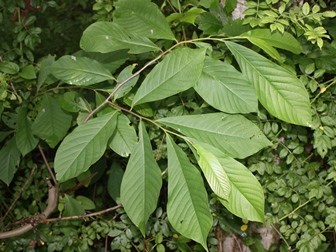
NPS Photo Pawpaw is a small native tree, usually standing around 20 to 30 feet tall. It is easily recognizable by its large ovate leaves, which give off a noticeable scent when torn or bruised. Pawpaw will sprout deep purple flowers, and grow light-to-dark green fruit that will soften when ripe. While the skin and seeds are inedible, the pulp of this fruit is edible, with the taste resembling that of a banana or mango. In the park, you will see Pawpaw growing along floodplains and moist forests. This species will form dense thickets, as they can grow additional stems from root suckers and create a clump from the same individual.
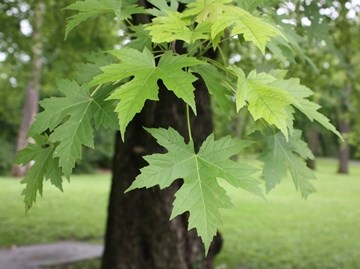
NPS Photo One of the most abundant trees within the C&O Canal is the Silver Maple, due to its preference for moist soils found in floodplains, near streams, and in low-lying forests. Silver Maples can be identified by the silvery underside of their leaves, their large seeds, and their deep-lobed leaf shape. In contrast, other maple species prefer higher elevations, and generally have smaller seeds and wider leaves with rounded lobes. Silver Maples can grow between 40 and 80 feet tall.
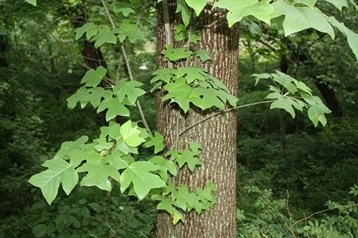
NPS Photo Also called Yellow Poplar and Tuliptree, Tulip Poplar can be found growing in moist soil at both high and low elevations. This particular species may reach between 60 and 100 feet in height, and is usually lacking lower branches. The Tulip Poplar gets it name from its tulip-shaped leaves and pretty tulip-like flowers that bloom in early spring. These flowers are followed by cone-shaped brown fruit with winged seeds.
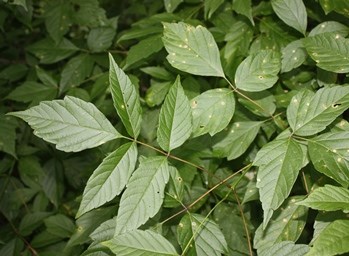
NPS Photo Box Elder, a species of maple, is the most common tree species within the C&O Canal. This species can tolerate a wide range of soil conditions and has very rapid growth. While it produces wind-blown seeds and small green flowers, Box Elder stands out from other maple species by having three to five leaflets instead of a simple leaf. They also have a shrubby appearance and growth form, as opposed to the taller Silver and Sugar Maples. It is medium-sized tree, growing between 35 and 50 feet in height.
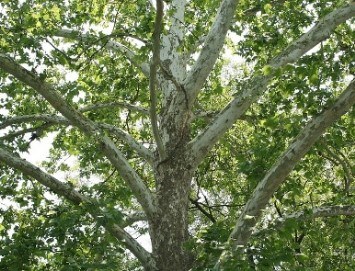
The American Sycamore is likely the most distinctive and easily identified tree in Maryland, due to its peeling outer bark, white inner bark, and affinity for water and moist soils. This species is often found lining streams and rivers, and as such can be seen throughout the length of the canal. One of our largest trees, the Sycamore can grow well over 100 feet in height and has large maple-like leaves. In the fall, trees will produce fruiting balls, densely packed with fluffy seeds called achenes.
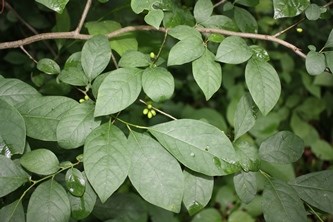
NPS Photo Northern Spicebush grows well in moist areas along streams, and bottomland woods and valleys, making it a prevalent sight along the towpath. This plant is a medium-sized shrub, growing 6 to 12 feet tall. Each individual of this species is either male or female, instead of having both reproductive organs like many plant species. The leaves, greenish-yellow flowers, and red berry-like fruit of this plant are all very aromatic and pleasant-smelling.
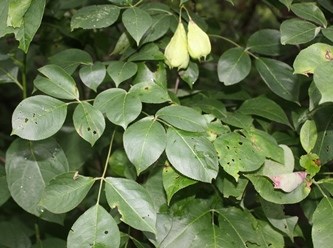
NPS Photo One of the larger shrubs found within the park, American Bladdernut grows to nearly 15 feet tall and stands out due to its distinct flowers and fruit. The flowers are small, white and bell-shaped and grow in drooping clusters. The fruit of the American Bladdernut are light green, egg-shaped, papery seed capsules which mature in late summer and can persist until early winter. This species can tolerate a variety of different soil types, and can be found in woodland thickets and along streams, usually preferring shaded areas.
|
Last updated: August 1, 2016
